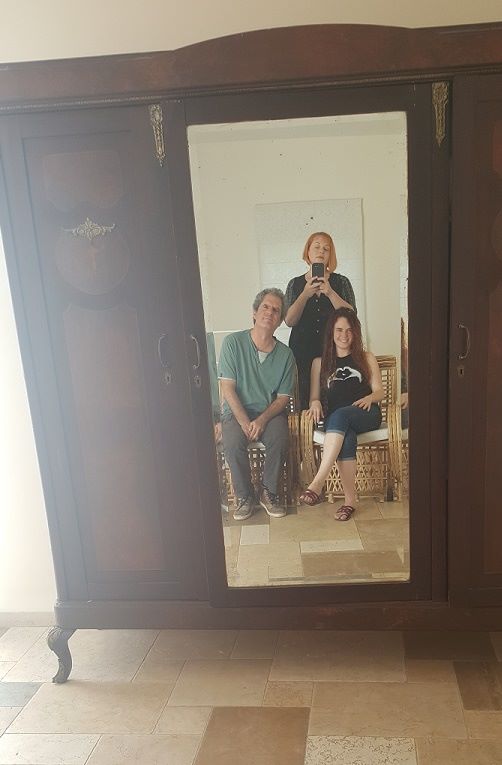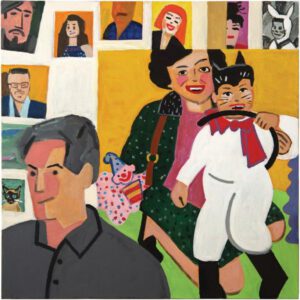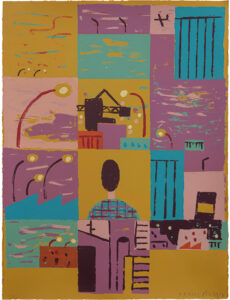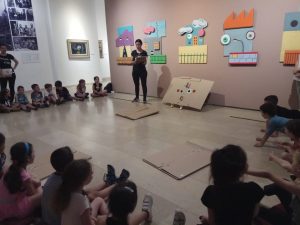Oded Zaidel – Paintings, 2018-19
curator: Orna Noy Lanir, February 2019, Agripas 12 Gallery, Jerusalem
In the self-portrait, his reflection somewhat shifted, the painter shuts his eyes, his attention tuned to voices echoing from within a shell; there’s no way of knowing whether those are the sounds of wind or faraway waves, or perhaps a resonance of something stored within himself, now whispered in his ear, evoking hidden associations. Behind, there are a painting of intensely colored frame and a grey armchair to one side, bookshelves and a doorframe to the other; is it open or closed?Itscontour—a green line—forms a square in shortening, creating a voluminous space. The shell’s form is sending out arms, its foreignness invading the painting’s space, distinct lines and color planes. Although it continues the same manner of treating the color planes and the lines, this is a different painting—its “otherness” seems to suggest a different reading into this solo exhibition whose scope is the period at which the paintings were created.
The paintings in the exhibition are divided into two:to the continued treatment of industrial sites and locations bereft of humans, are added paintings based on group “selfies” of family and friends. In the picturesque expanse, the “selfie” creates an action wherein, as in panoramic paintings, the point of view is an organizing element, gathering and editing the images into the frame and along the painting’s plane, thus creating paintings with a language of their own, that stands apart from symbolization and representation.
Thus, opposite the slow passive sites on which spill loneliness and fine marginal dust, enter fast lively encounters of social events frozen for a short moment by the gesture of photography; and although the documented persons are focused on their respective reflections, one can feel a binding connection, painted in compassionate humor and using a color palate that changes in accordance. The panoramic paintings in which the condensation of detailing and delimitation seems to simulate inner locations and landscapes where loneliness is merely quietude, may give rise to a new reading.
An affinity can be seen to Russian avant-garde painters such as Alexander Rodchenko, El Lissitzky and Kazimir Malevich in the deconstruction and reconstruction of images styled in geometrical shapes, and even more so to the American Precisionism movement, namely Ralston Crawford and Niles Spencer, who portrayed urban areas and industrial buildings fashioned in geometric diminution, both under apparent Cubistic influence. Familiar with Precisionism, Eduard Hopper—the similarity of his paintings of abandoned industrial areas to those of Zaidel’s stands out instinctively—was active parallel to them. Headamantly declared that despite his paintings’ mood of estrangement and melancholy, the thing that was of interest to him rather than any symbolism of sorts was the sunlight falling on buildings and persons. The local searing sunlight engages Zaidel and appears as a pigment absorbed with material, reminiscent of Uri Reismanin the color planes and the saturated spaces that are equal and functionas images in the landscape paintings, the same as in portraits.
In his paintings, Zaidel continues on his way, where he takes almost defying liberties not to act within the confines of artistic language, so that what is seen in it alienates the familiar and raises questions regarding color and shape, correctness, definition of space and gestalt; questions that remain open and invite the viewer to dialogue. A yellow wall shining and a darkening skyscape kissing the ground line, a blotch of a green dress with a solidifying space by its side. Paintings.
What is a family portrait? Is it a cherished picture of a single core family? Or perhaps specifically not. Usually, when we think of a family portrait, photos of our near and distant past immediately pop up and rise into our mind´s eyes: around the holiday table, on a trip into nature, at the beach, at Grandma and Grandpa´s house, etc., etc.
What is the ultimate family portrait? It may be a picture that has become an icon for the family, that has gone beyond the category of the banal, the everyday, and entered into the category of the holy, the eternal.
Is this how we feel about the pictures that have come down to us from our grandparents´ homes, pictures that were hanging for generations in the living rooms of the family?
Perhaps these are pictures that are even more primal, more tribal. These may depict scenes of the beginnings of a new tribe, a new people, or a new religion. Is there any more ultimate and more holy (and more painted) family than the family of Miriam and Joseph of Nazareth? This family has gone through so many transformations and has adopted so many different appearances. We all know well the scene of the birth in the manger, or the Crucifixion in the Calvary from imaginative portraits. There always appears the father, the mother and the son. As time passed, though, in addition to the core family, portraits of the underwriters of the paintings were added – usually outside of the picture, to the right or to the left, as if they sought to be also included in this family, or at least to bask in its holiness.
Text by Yossi Waxman for the group exhibition “The Artist´s Family”, 2018
Participants: Ben Simon, Yossi Waxman, Lena Zaidel, Oded Zaidel, Agripas 12 Gallery, Jerusalem
Curators: Lena Zaidel, Yossi Waxman
















